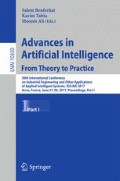Abstract
This paper presents the implementation of a qualitative spatial reasoning formalism called Interval Occlusion Calculus based on Allen’s Algebra, that considers multiple viewpoints in a scene and the interpretation of the observations made from each point from the perspective of other agents. Furthermore we present a mechanism to check consistency for the information provided by the agents using a constraint satisfaction process. This formalism was tested in a 3D domain with real and simulated robot’s viewpoints.
Access this chapter
Tax calculation will be finalised at checkout
Purchases are for personal use only
References
Allen, J.F.: Maintaining knowledge about temporal intervals. Commun. ACM 26(11), 832–843 (1983)
Karacapidilis, N.I., Papadias, D., Egenhofer, M.J.: Collaborative spatial decision making with qualitative constraints. In: ACM-GIS, pp. 53–59 (1995)
Doherty, P., Heintz, F., Landén, D.: A delegation-based architecture for collaborative robotics. In: Weyns, D., Gleizes, M.-P. (eds.) AOSE 2010. LNCS, vol. 6788, pp. 205–247. Springer, Heidelberg (2011). doi:10.1007/978-3-642-22636-6_13
Cohn, A.G., Renz, J.: Chapter 13 qualitative spatial representation and reasoning. In: Handbook of Knowledge Representation, vol. 3, pp. 551–596 (2008)
Tarquini, F., Felice, G., Fogliaroni, P., Clementini, E.: A qualitative model for visibility relations. In: Hertzberg, J., Beetz, M., Englert, R. (eds.) KI 2007, LNAI, vol. 4667, pp. 510–513. Springer, Heidelberg (2007)
Santos, P.E., Ligozat, G., Safi-Samghabad, M.: An occlusion calculus based on an interval algebra. In: Proceedings-2015 Brazilian Conference on Intelligent Systems, BRACIS 2015, pp. 128–133 (2016)
Petrov, A., Kuzmin, L.: Visual space geometry derived from occlusion axioms. J. Math. Imaging Vis. 6(2–3), 291–308 (1996). Springer
Galton, A.: Lines of sight. In: AISB Workshop on Spatial and Spatio-Temporal Reasoning (1994)
Randell, D.A., Cui, Z., Cohn, A.G.: A spatial logic based on regions and connection. In: Nebel, B., Swartout, W., Rich, C. (eds.) Proceedings of the 3rd International Conference on Knowledge Representation and Reasoning, pp. 165-176. Morgan Kaufmann, Los Altos, CA (1992)
Randell, D., Witkowski, M., Shanahan, M.: From images to bodies: modelling and exploiting spatial occlusion and motion parallax. In: IJCAI International Joint Conference on Artificial Intelligence, pp. 57–63 (2001). ISSN 10450823
Villemaire, R., Hallé, S.: Reasoning about visibility. J. Appl. Logic 10(2), 163–178 (2012). Elsevier
Guha, P., Mukerjee, A., Venkatesh, K.S.: OCS-14: you can get occluded in fourteen ways. In: Proceedings of the Twenty-Second International Joint Conference on Artificial Intelligence, IJCAI 2011, vol. 2, pp. 1665–1670. AAAI Press (2011)
Sabharwal, C.L.: A complete classification of occlusion observer’s point of view for 3D qualitative spatial reasoning. In: The proceedings of 21st International Conference on Distributed Multimedia Systems, and Journal of Visual Languages and Sentient Systems, vol. 1, pp. 94–100 (2015)
Tassoni, S., Fogliaroni, P., Bhatt, M., Felice, G.D.: Toward a qualitative 3D visibility model. In: 25th International Workshop on Qualitative Reasoning, Co-located with the IJCAI-11 Conference, Barcelona, Spain (2011)
Ligozat, G.: Qualitative Spatial and Temporal Reasoning. Wiley, New York (2013)
Author information
Authors and Affiliations
Corresponding author
Editor information
Editors and Affiliations
Rights and permissions
Copyright information
© 2017 Springer International Publishing AG
About this paper
Cite this paper
Martin, A.P., Santos, P.E., Safi-Samghabadi, M. (2017). Consistency Check in a Multiple Viewpoint System for Reasoning About Occlusion. In: Benferhat, S., Tabia, K., Ali, M. (eds) Advances in Artificial Intelligence: From Theory to Practice. IEA/AIE 2017. Lecture Notes in Computer Science(), vol 10350. Springer, Cham. https://doi.org/10.1007/978-3-319-60042-0_58
Download citation
DOI: https://doi.org/10.1007/978-3-319-60042-0_58
Published:
Publisher Name: Springer, Cham
Print ISBN: 978-3-319-60041-3
Online ISBN: 978-3-319-60042-0
eBook Packages: Computer ScienceComputer Science (R0)

